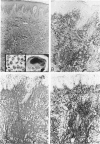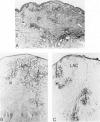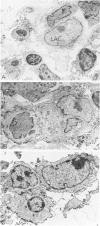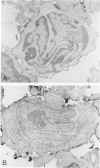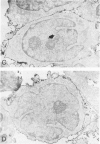Abstract
A distinctive immunologic phenotype was demonstrated for the characteristic large atypical cells in skin lesions of 9 patients with lymphomatoid papulosis (LP). Coexpression of Hodgkin's disease (HD)-associated antigen(s) Ki-1, and often Leu-M1, with helper T-cell antigens T11, T4, and T3 and cellular activation antigens Tac, Ia, and T9 was the most common phenotype, observed in 6 of 9 cases. In 2 cases T-cell-specific antigens were not detected, and the phenotype was indistinguishable from Reed-Sternberg (RS) cells of HD. Numerous Ki-1 positive cells and infrequent expression of Leu-1 antigen by large atypical cells in LP cases facilitated the differential diagnosis between LP and mycosis fungoides. A possible transition between small, medium, and large cells expressing only T-cell antigens and large transformed RS-like cells expressing both T-cell and HD-associated antigens was shown by immunoelectron microscopy. These immunologic findings should prove useful for the diagnosis of LP and may help to explain the unexpectedly frequent clinical associations of LP, mycosis fungoides, and HD.
Full text
PDF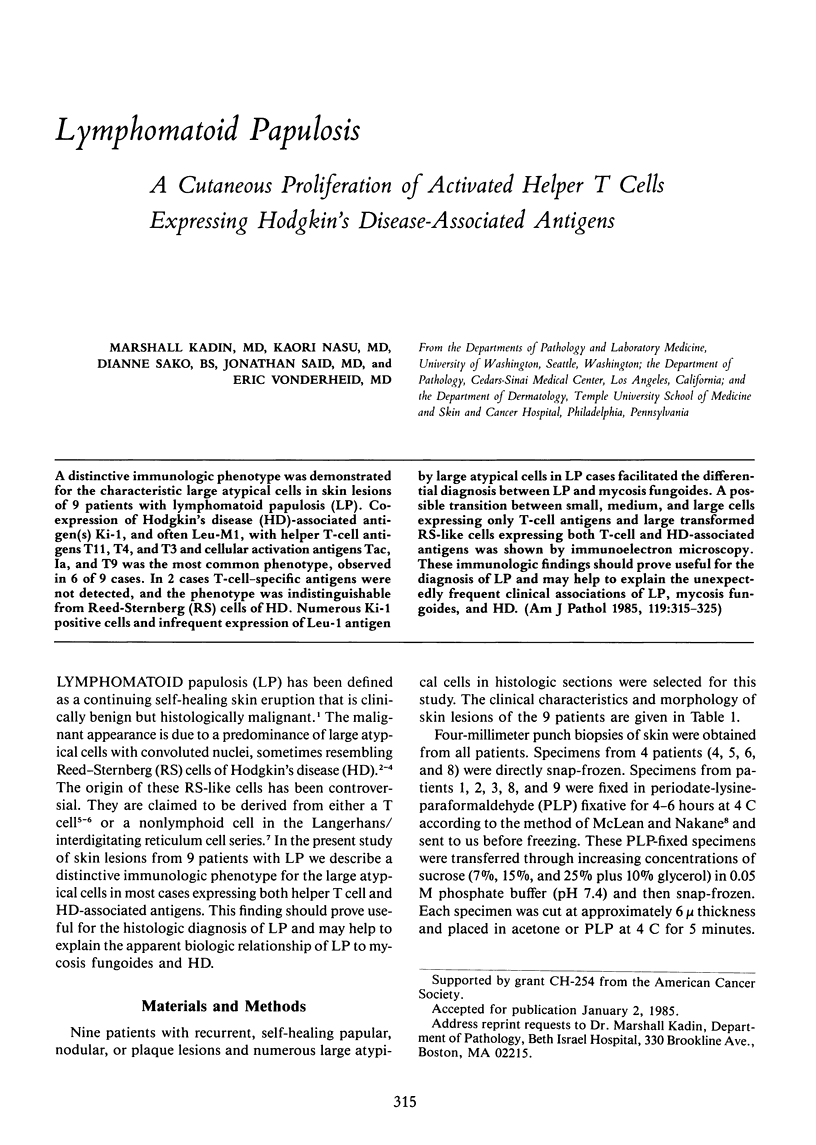
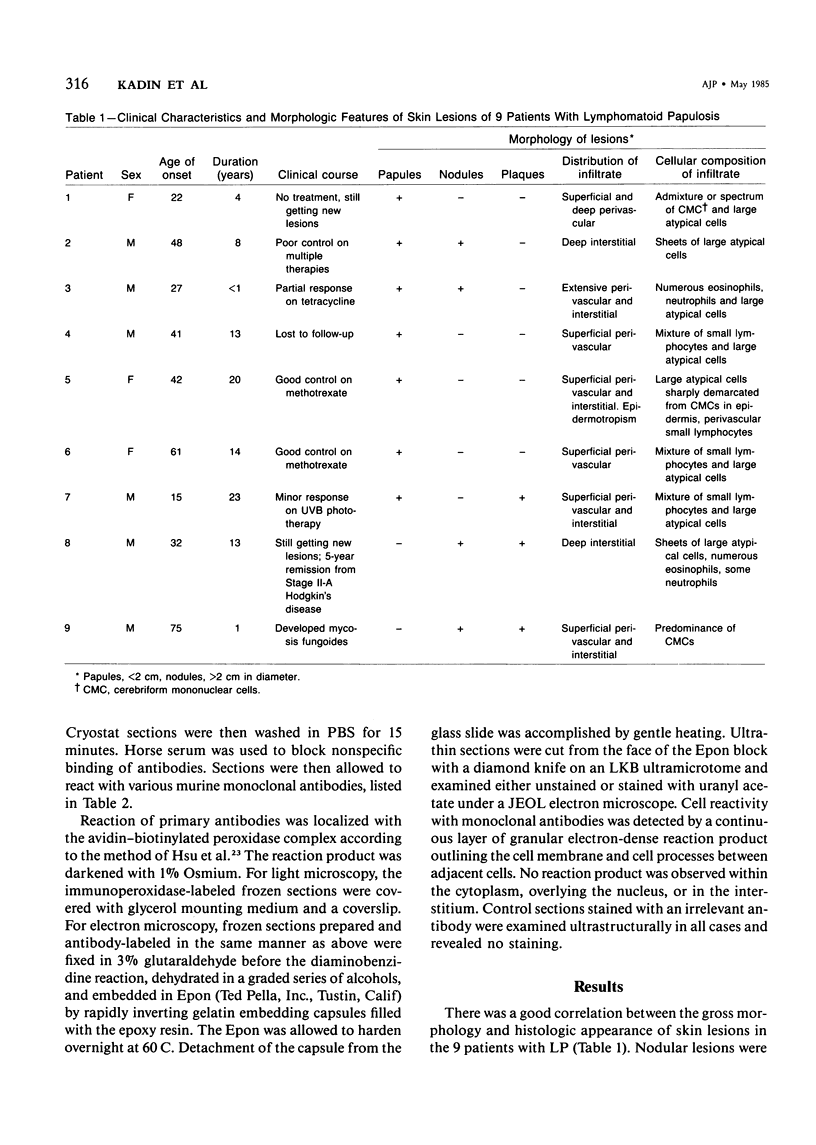
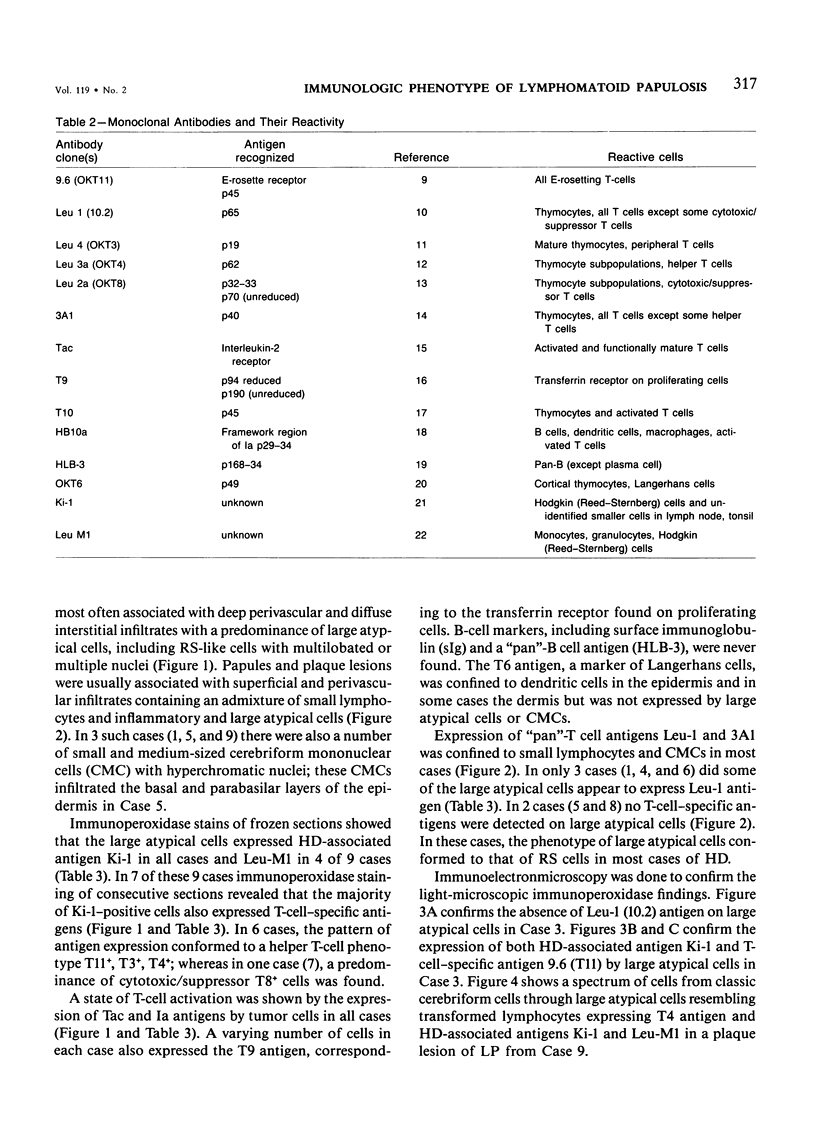
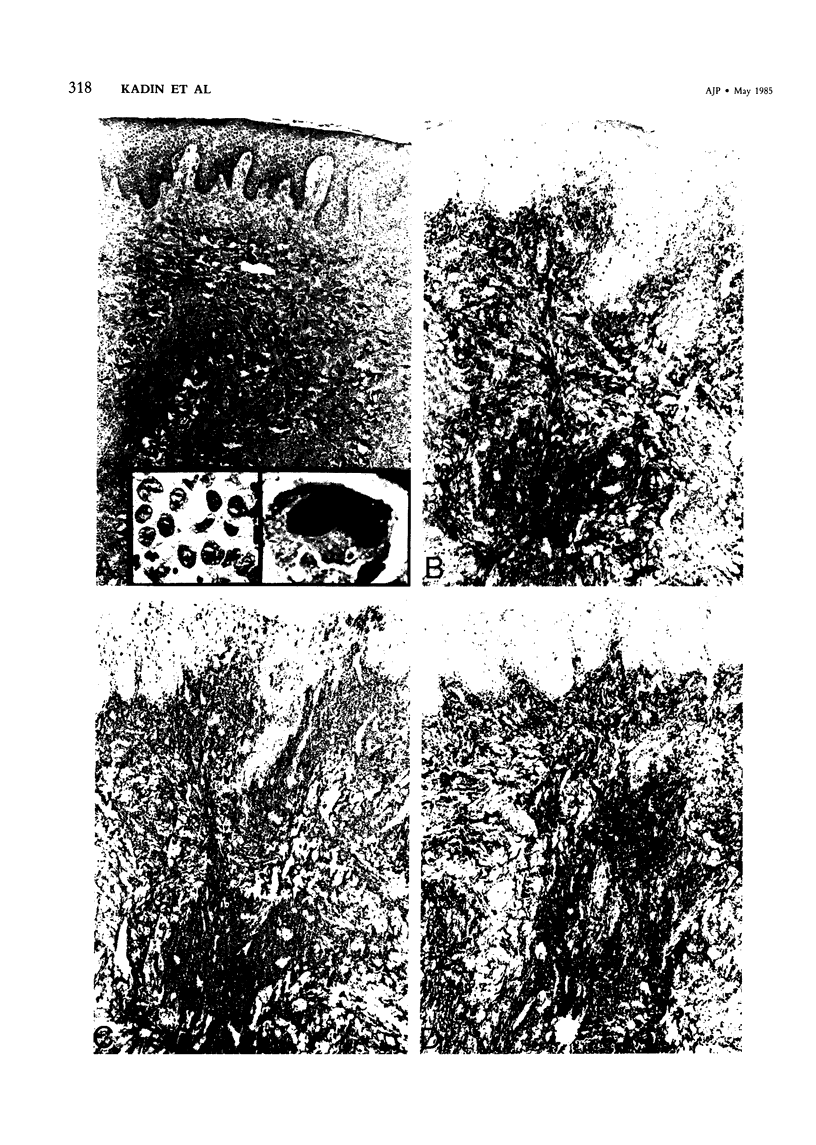
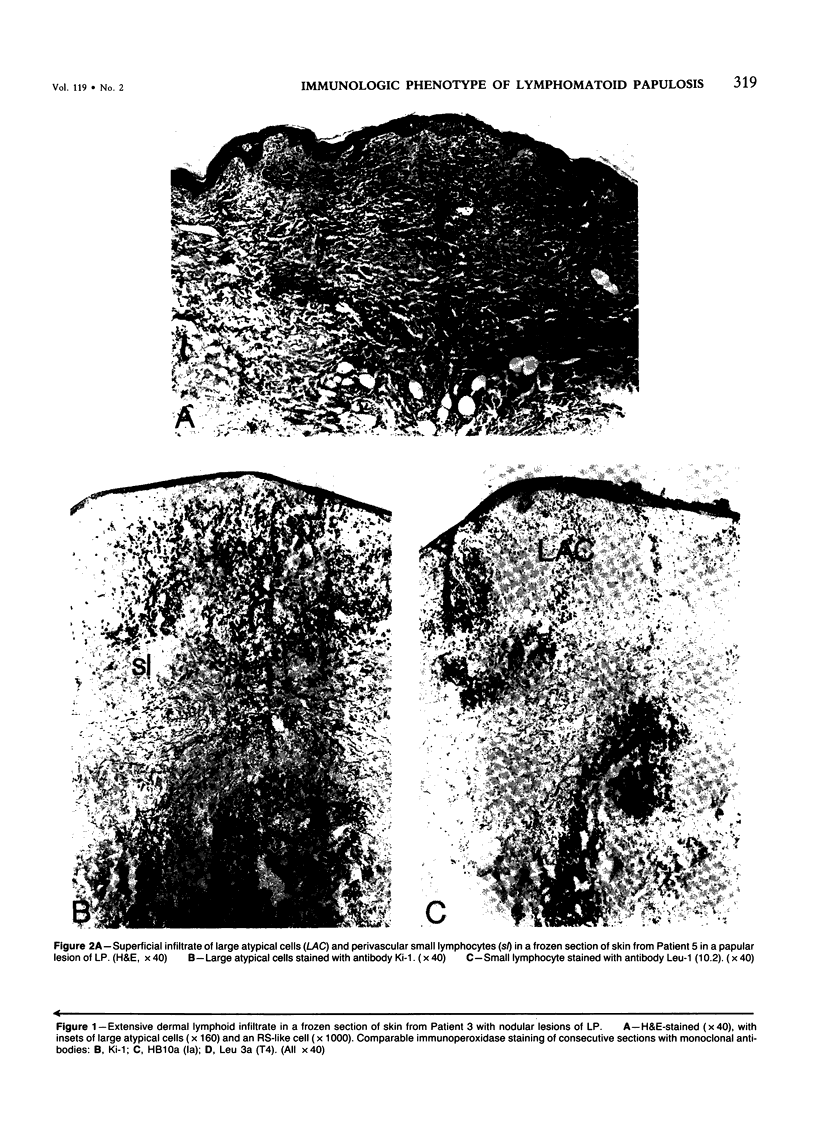
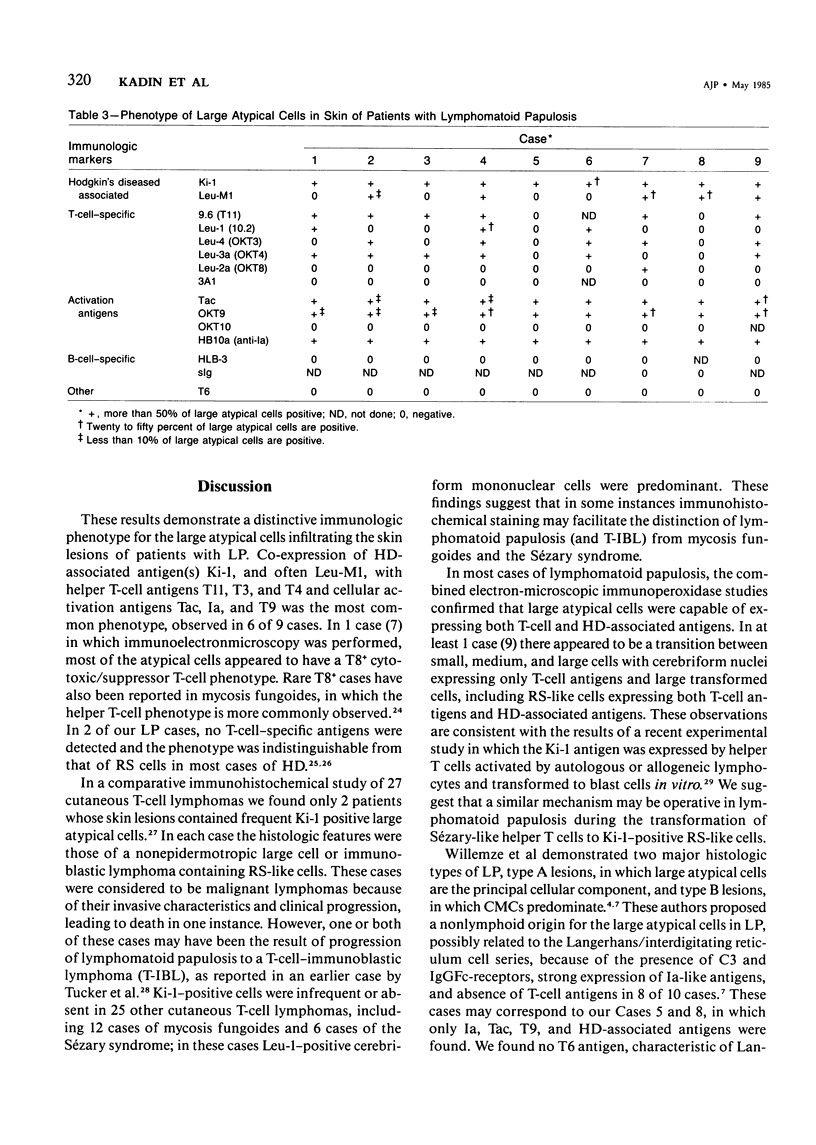
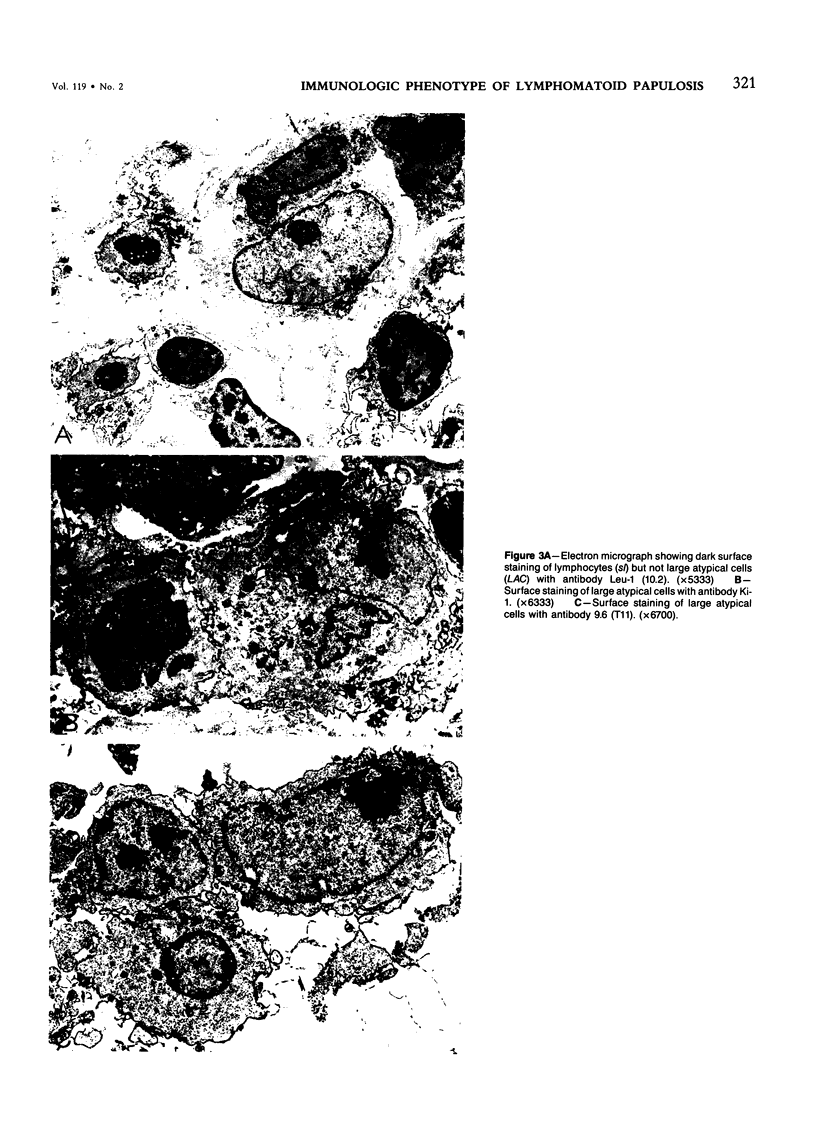
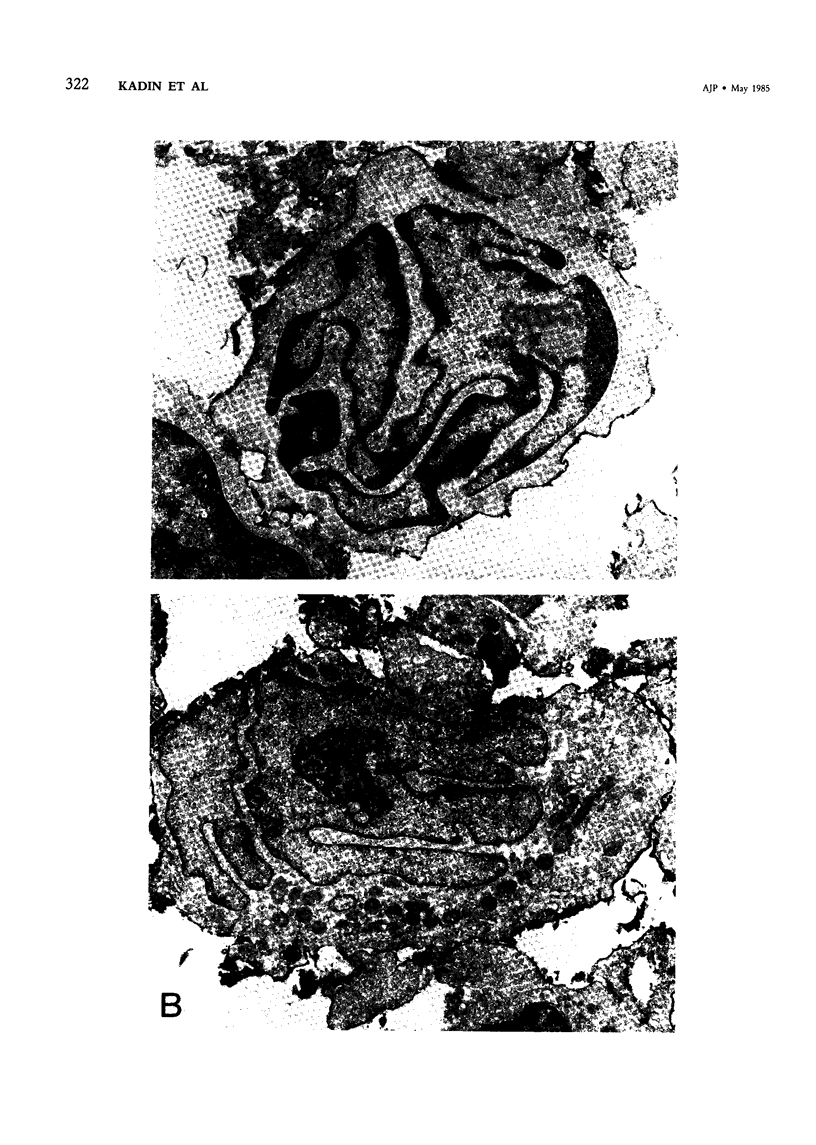
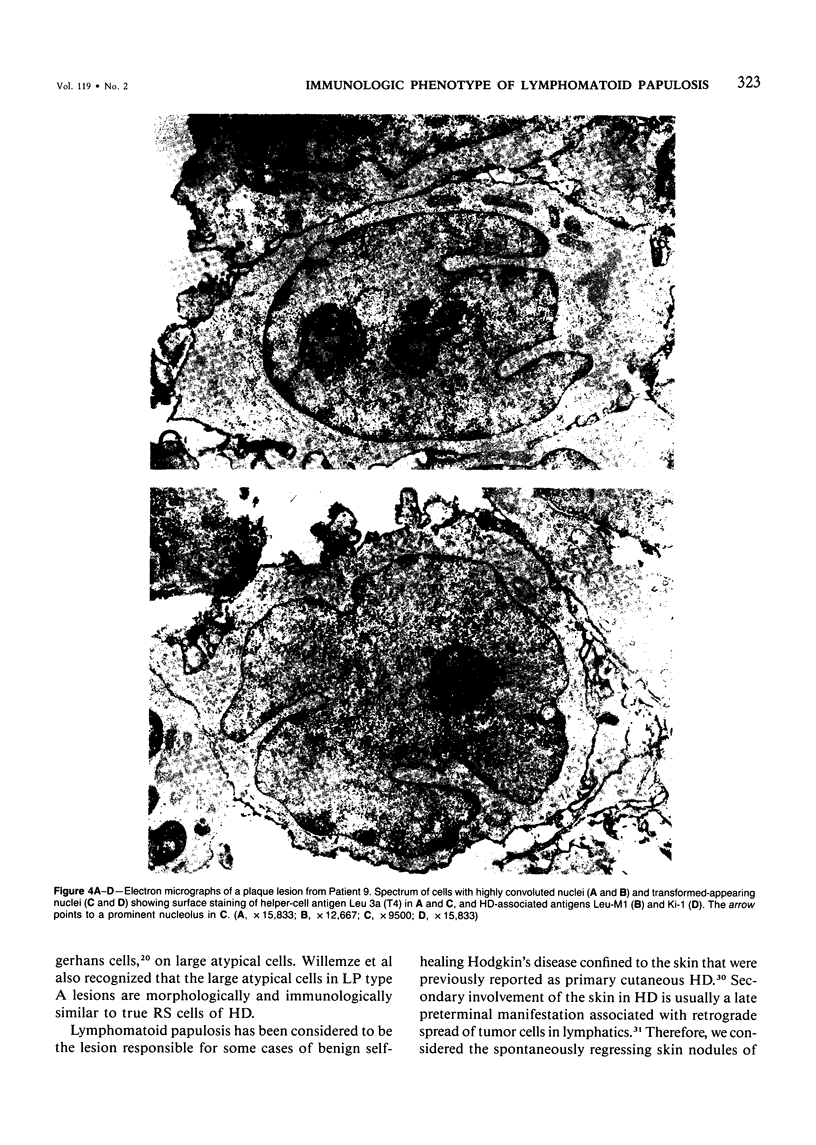
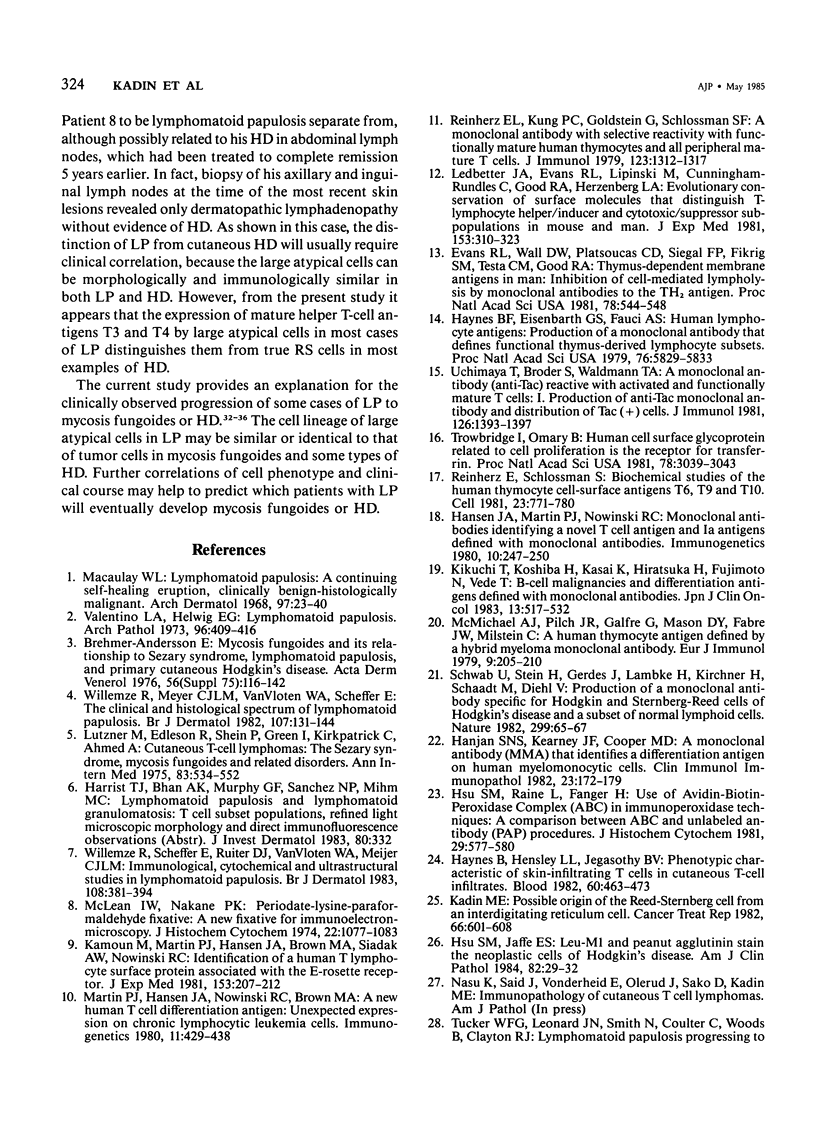
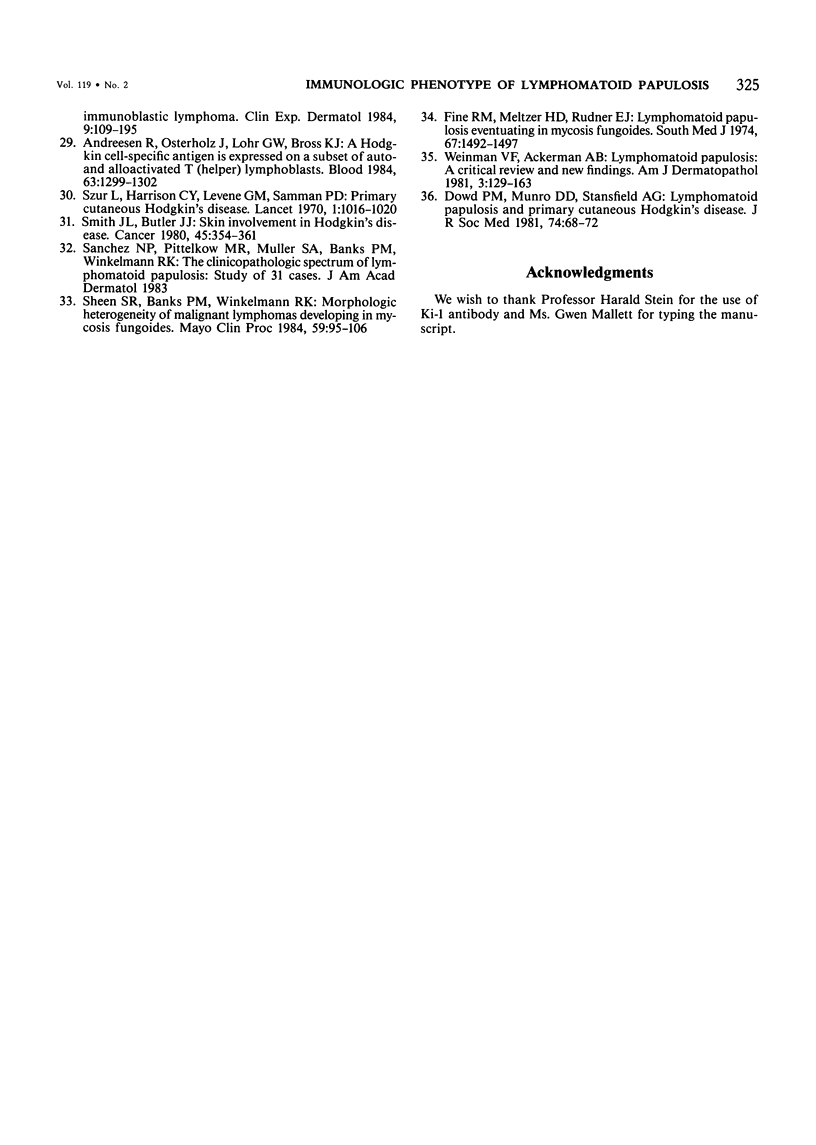
Images in this article
Selected References
These references are in PubMed. This may not be the complete list of references from this article.
- Andreesen R., Osterholz J., Löhr G. W., Bross K. J. A Hodgkin cell-specific antigen is expressed on a subset of auto- and alloactivated T (helper) lymphoblasts. Blood. 1984 Jun;63(6):1299–1302. [PubMed] [Google Scholar]
- Brehmer-Andersson E. Mycosis fungoides and its relation to Sézary's syndrome, lymphomatoid papulosis, and primary cutaneous Hodgkin's disease. A clinical, histopathologic and cytologic study of fourteen cases and a critical review of the literature. Acta Derm Venereol Suppl (Stockh) 1976;56(75):3–142. [PubMed] [Google Scholar]
- Dowd P. M., Munro D. D., Stansfeld A. G. Lymphomatoid papulosis and primary cutaneous Hodgkin's disease. J R Soc Med. 1981 Jan;74(1):68–71. doi: 10.1177/014107688107400114. [DOI] [PMC free article] [PubMed] [Google Scholar]
- Evans R. L., Wall D. W., Platsoucas C. D., Siegal F. P., Fikrig S. M., Testa C. M., Good R. A. Thymus-dependent membrane antigens in man: inhibition of cell-mediated lympholysis by monoclonal antibodies to TH2 antigen. Proc Natl Acad Sci U S A. 1981 Jan;78(1):544–548. doi: 10.1073/pnas.78.1.544. [DOI] [PMC free article] [PubMed] [Google Scholar]
- Fine R. M., Meltzer H. D., Rudner E. J. Lymphomatoid papulosis eventuating in mycosis fungoides. South Med J. 1974 Dec;67(12):1492–1497. doi: 10.1097/00007611-197412000-00025. [DOI] [PubMed] [Google Scholar]
- Hanjan S. N., Kearney J. F., Cooper M. D. A monoclonal antibody (MMA) that identifies a differentiation antigen on human myelomonocytic cells. Clin Immunol Immunopathol. 1982 May;23(2):172–188. doi: 10.1016/0090-1229(82)90106-4. [DOI] [PubMed] [Google Scholar]
- Haynes B. F., Eisenbarth G. S., Fauci A. S. Human lymphocyte antigens: production of a monoclonal antibody that defines functional thymus-derived lymphocyte subsets. Proc Natl Acad Sci U S A. 1979 Nov;76(11):5829–5833. doi: 10.1073/pnas.76.11.5829. [DOI] [PMC free article] [PubMed] [Google Scholar]
- Haynes B. F., Hensley L. L., Jegasothy B. V. Phenotypic characterization of skin-infiltrating T cells in cutaneous T-cell lymphoma: comparison with benign cutaneous T-cell infiltrates. Blood. 1982 Aug;60(2):463–473. [PubMed] [Google Scholar]
- Hsu S. M., Jaffe E. S. Leu M1 and peanut agglutinin stain the neoplastic cells of Hodgkin's disease. Am J Clin Pathol. 1984 Jul;82(1):29–32. doi: 10.1093/ajcp/82.1.29. [DOI] [PubMed] [Google Scholar]
- Hsu S. M., Raine L., Fanger H. Use of avidin-biotin-peroxidase complex (ABC) in immunoperoxidase techniques: a comparison between ABC and unlabeled antibody (PAP) procedures. J Histochem Cytochem. 1981 Apr;29(4):577–580. doi: 10.1177/29.4.6166661. [DOI] [PubMed] [Google Scholar]
- Kadin M. E. Possible origin of the Reed-Sternberg cell from an interdigitating reticulum cell. Cancer Treat Rep. 1982 Apr;66(4):601–608. [PubMed] [Google Scholar]
- Kamoun M., Martin P. J., Hansen J. A., Brown M. A., Siadak A. W., Nowinski R. C. Identification of a human T lymphocyte surface protein associated with the E-rosette receptor. J Exp Med. 1981 Jan 1;153(1):207–212. doi: 10.1084/jem.153.1.207. [DOI] [PMC free article] [PubMed] [Google Scholar]
- Kikuchi K., Koshiba H., Kasai K., Hiratsuka H., Fujimoto N., Uede T. B-cell malignancies and differentiation antigens defined with monoclonal antibodies. Jpn J Clin Oncol. 1983 Sep;13(3):517–531. [PubMed] [Google Scholar]
- Ledbetter J. A., Evans R. L., Lipinski M., Cunningham-Rundles C., Good R. A., Herzenberg L. A. Evolutionary conservation of surface molecules that distinguish T lymphocyte helper/inducer and cytotoxic/suppressor subpopulations in mouse and man. J Exp Med. 1981 Feb 1;153(2):310–323. doi: 10.1084/jem.153.2.310. [DOI] [PMC free article] [PubMed] [Google Scholar]
- Lutzner M., Edelson R., Schein P., Green I., Kirkpatrick C., Ahmed A. Cutaneous T-cell lymphomas: the Sézary syndrome, mycosis fungoides, and related disorders. Ann Intern Med. 1975 Oct;83(4):534–552. doi: 10.7326/0003-4819-83-4-534. [DOI] [PubMed] [Google Scholar]
- Macaulay W. L. Lymphomatoid papulosis. A continuing self-healing eruption, clinically benign--histologically malignant. Arch Dermatol. 1968 Jan;97(1):23–30. doi: 10.1001/archderm.97.1.23. [DOI] [PubMed] [Google Scholar]
- Martin P. J., Hansen J. A., Nowinski R. C., Brown M. A. A new human T-cell differentiation antigen: unexpected expression on chronic lymphocytic leukemia cells. Immunogenetics. 1980;11(5):429–439. doi: 10.1007/BF01567812. [DOI] [PubMed] [Google Scholar]
- McLean I. W., Nakane P. K. Periodate-lysine-paraformaldehyde fixative. A new fixation for immunoelectron microscopy. J Histochem Cytochem. 1974 Dec;22(12):1077–1083. doi: 10.1177/22.12.1077. [DOI] [PubMed] [Google Scholar]
- McMichael A. J., Pilch J. R., Galfré G., Mason D. Y., Fabre J. W., Milstein C. A human thymocyte antigen defined by a hybrid myeloma monoclonal antibody. Eur J Immunol. 1979 Mar;9(3):205–210. doi: 10.1002/eji.1830090307. [DOI] [PubMed] [Google Scholar]
- Reinherz E. L., Kung P. C., Goldstein G., Schlossman S. F. A monoclonal antibody with selective reactivity with functionally mature human thymocytes and all peripheral human T cells. J Immunol. 1979 Sep;123(3):1312–1317. [PubMed] [Google Scholar]
- Scheen S. R., 3rd, Banks P. M., Winkelmann R. K. Morphologic heterogeneity of malignant lymphomas developing in mycosis fungoides. Mayo Clin Proc. 1984 Feb;59(2):95–106. doi: 10.1016/s0025-6196(12)60243-2. [DOI] [PubMed] [Google Scholar]
- Schwab U., Stein H., Gerdes J., Lemke H., Kirchner H., Schaadt M., Diehl V. Production of a monoclonal antibody specific for Hodgkin and Sternberg-Reed cells of Hodgkin's disease and a subset of normal lymphoid cells. Nature. 1982 Sep 2;299(5878):65–67. doi: 10.1038/299065a0. [DOI] [PubMed] [Google Scholar]
- Smith J. L., Jr, Butler J. J. Skin involvement in Hodgkin's disease. Cancer. 1980 Jan 15;45(2):354–361. doi: 10.1002/1097-0142(19800115)45:2<354::aid-cncr2820450227>3.0.co;2-#. [DOI] [PubMed] [Google Scholar]
- Szur L., Harrison C. V., Levene G. M., Samman P. D. Primary cutaneous Hodgkin's disease. Lancet. 1970 May 16;1(7655):1016–1020. doi: 10.1016/s0140-6736(70)91149-9. [DOI] [PubMed] [Google Scholar]
- Terhorst C., van Agthoven A., LeClair K., Snow P., Reinherz E., Schlossman S. Biochemical studies of the human thymocyte cell-surface antigens T6, T9 and T10. Cell. 1981 Mar;23(3):771–780. doi: 10.1016/0092-8674(81)90441-4. [DOI] [PubMed] [Google Scholar]
- Trowbridge I. S., Omary M. B. Human cell surface glycoprotein related to cell proliferation is the receptor for transferrin. Proc Natl Acad Sci U S A. 1981 May;78(5):3039–3043. doi: 10.1073/pnas.78.5.3039. [DOI] [PMC free article] [PubMed] [Google Scholar]
- Uchiyama T., Broder S., Waldmann T. A. A monoclonal antibody (anti-Tac) reactive with activated and functionally mature human T cells. I. Production of anti-Tac monoclonal antibody and distribution of Tac (+) cells. J Immunol. 1981 Apr;126(4):1393–1397. [PubMed] [Google Scholar]
- Valentino L. A., Helwig E. B. Lymphomatoid papulosis. Arch Pathol. 1973 Dec;96(6):409–416. [PubMed] [Google Scholar]
- Weinman V. F., Ackerman A. B. Lymphomatoid papulosis. A critical review and new findings. Am J Dermatopathol. 1981 Summer;3(2):129–163. doi: 10.1097/00000372-198100320-00004. [DOI] [PubMed] [Google Scholar]
- Willemze R., Meyer C. J., Van Vloten W. A., Scheffer E. The clinical and histological spectrum of lymphomatoid papulosis. Br J Dermatol. 1982 Aug;107(2):131–144. doi: 10.1111/j.1365-2133.1982.tb00331.x. [DOI] [PubMed] [Google Scholar]
- Willemze R., Scheffer E., Ruiter D. J., van Vloten W. A., Meijer C. J. Immunological, cytochemical and ultrastructural studies in lymphomatoid papulosis. Br J Dermatol. 1983 Apr;108(4):381–394. doi: 10.1111/j.1365-2133.1983.tb04591.x. [DOI] [PubMed] [Google Scholar]



